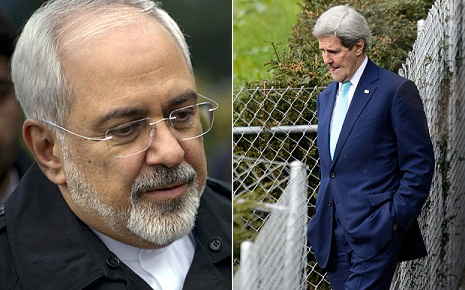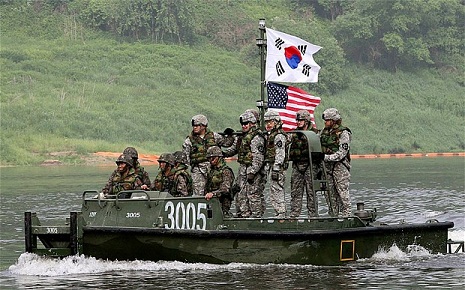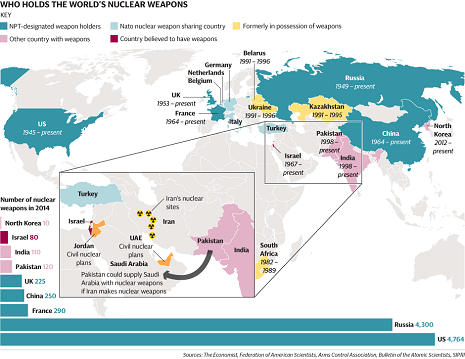
Dozens of states that considered nuclear weapons from the Sixties to the Eighties never took the plunge. These included Sweden, South Korea and Taiwan. Others, like South Africa and Ukraine, voluntarily gave up arsenals in their possession. This fortuitous legacy is in part due to the cost and difficulty of building these complex weapons. But it is also the product of the Non-Proliferation Treaty (NPT) of 1970, an audaciously successful attempt to lock in the nuclear monopolies of the time.
Now, however, the nuclear sands are shifting under our feet from North America to Asia Pacific.
First, consider the potential nuclear aspirants. Israel and Arab nations, above all the Persian Gulf monarchies, have watched the unfolding Iran diplomacy in Lausanne with apprehension, growing into alarm. Much of their fear has little to do with nuclear weapons, and stems more from their conviction that Iranian power has ineluctably grown over the past decade, in part thanks to American fecklessness and timidity. They view the emerging deal as unduly generous to Tehran, and therefore likely either to collapse or fall prey to Iranian cheating.
Israel enjoys the luxury of around 80 nuclear weapons, deliverable with great precision to any spot in Iran from land, air or sea.
But the Arab states do not. Most of these countries are in no position to produce or procure a bomb. Egypt, for instance, lacks the cash and is anyway distracted by Islamist challenges at home and in next-door Libya. Some of these countries, such as the UAE and Jordan, are laying the basis of civil nuclear programmes, designed to produce energy, and they may choose to accelerate these as a largely symbolic way of matching Iran’s status.
One state may aim at something higher. Saudi Arabian officials, including senior royals, have for the past several years loudly told anyone who would listen that they will not stand idly by if Iran acquires the bomb, or looks perilously close to doing so. It is widely believed that Saudi Arabia and Pakistan have a long-standing arrangement whereby the latter, cash-strapped and often pressed into rendering service to its wealthier Muslim ally, would supply nuclear weapons or technology to the Kingdom on short notice. Saudi Arabia may feel confident that its status as an oil producer makes it immune from the sort of sanctions that have forced Iran to the negotiating table. But would Pakistan really risk international opprobrium, probable sanctions, and the complete collapse of its already fragile alliance with the United States merely to placate Riyadh? Short of concrete Iranian steps towards a bomb, I doubt it. But our intelligence agencies will be closely watching the flow of scientists and officials between the two countries in the months ahead.
Second, we have the nuclear aristocrats. The United States and Russia still keep nearly 2,000 missiles on hair-trigger alert, ready to launch within five to 15 minutes of an order. The last great US-Russia arms control treaty, in which each side pledged to slash their deployed warheads by a third, was signed in 2010. The collapse of Russia’s relationship with the West in the five years since has ended hopes of further progress. Washington is spending an eye-watering $8 billion to extend the life of its air-dropped bombs, and American military strategists continue to view nuclear weapons as useful, even indispensable, in a wide range of military scenarios, such as a US-China war that breaks out over Taiwan or a North Korean invasion of the South.

Some American experts have even predicted the death of Mutually Assured Destruction, by floating the suggestion that US nuclear forces and targeting capabilities are the point where they could soon mount a successful first strike, completely destroying an enemy’s nuclear forces before they can be used. Such ideas are both outlandish and dangerous.
In Moscow, meanwhile, nuclear weapons are assuming a greater prominence in the country’s defence posture. Russian officials have repeatedly threatened to deploy nuclear weapons into Crimea, and told US officials that they would reserve the right to use “nuclear force” in response to any movement of Nato forces into the Baltic states. These threats are, of course, psychological warfare; but they also reflect insecurities about the state of the creaking Russian army.
Europe, unsurprisingly, is in a muddle. France’s faith in nuclear weapons is unshakable. But in Britain, an SNP role in government or a shift in Labour policy could drastically change the nature of the deterrent, although a shift away from continuous submarine patrols would not necessarily be as catastrophic as the traditionalists argue. The more serious shift is within Nato, where five countries – Belgium, Germany, the Netherlands, Italy, and Turkey – play host to 200 tactical nuclear weapons. The first three of these countries are sceptical about the value of these weapons, and Germany may not even buy the F-35 aircraft necessary to carry them in the future.

Third, and finally, are the nuclear arrivistes. North Korea appears likelier to undertake a third nuclear test than restart negotiations, which it has abandoned several times since the Nineties. India and Pakistan are both increasing their arsenals, from a present total of about 100 each. Pakistan has exploited its nuclear shield to support violent Islamist groups across the region, safe in the knowledge that it can neither be attacked, nor allowed to collapse. It is now deploying short-range battlefield nuclear weapons designed to deter Indian tank columns.
Only a week ago, General Khalid Kidwai, the former director of Pakistan’s powerful Strategic Plans Division, the country’s main nuclear planning body, declared that Pakistan’s nukes “are not seen as separate weapons”, but are “very much integrated” with conventional forces. Pakistan is aping some of the worst mistakes of Nato’s Cold War policies, but in an environment where terrorist attacks are more frequent.
None of this is reason for panic. Europe is far less susceptible to annihilation than during the US-Soviet arms race, and India and Pakistani arsenals remain a fraction of the size of Western ones. More importantly, if Iran and the West can agree a nuclear deal, it will roll back Tehran’s nuclear programme and make it more transparent.
Implementation will be hard, and the deal’s expiry in a decade or so will throw up enormous challenges. But all this is a far better outcome than the renewed period of tit-for-tat sanctions, Iranian provocation, and eventually war, that might follow a collapse of negotiations.
Israel introduced nuclear weapons to the Middle East long ago, and there is a good chance that they will have proliferated no further even in another 10 or 20 years. Given the nuclear uncertainty in Europe and Asia, it would be no mean feat. And this may turn out to be a crucial week in securing that achievement.
More about:
















































